Otitis media symptoms, treatment, prevention
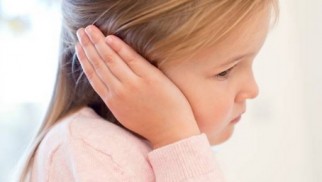
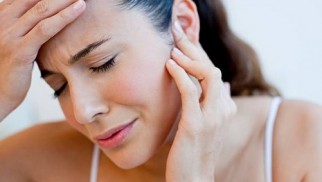
Anatomically, the ear consists of several sections, and inflammation can affect any of them. Most often, the infection affects the middle ear and causes acute otitis media (AOM).
Short information about otitis media
The development of a pathological condition is facilitated by:
- Hypothermia;
- Water getting into the ear (both sea water and from the pool) when swimming;
- Runny nose - otitis media in a child or an adult develops as a complication of rhinitis;
- Pressure drops during takeoff/landing of the aircraft.
The disease often strikes in summer and during the holiday season, in warm southern resorts. Otitis media in children develops against the background of measles and diphtheria, in adults it manifests itself in rhinopharyngitis, rhinosinusitis, adenoiditis and other ENT pathologies.
Acute otitis media is prone to transition into a chronic phase, in which the signs of otitis media become less pronounced.
Otolaryngologists distinguish three types of ENT pathologies:
- Eustachitis (inflammation of the eustachian tube). It occurs due to prolonged squeezing of the ear canal, which disrupts the air exchange of the tympanic cavity. A low pressure zone is created in the middle ear, the membrane is pulled inward. Gradually, fluid can accumulate in the ear cavity, which serves as a breeding ground for pathogens. Chronic diseases of the nasal cavity, as well as curvature of the septum, usually lead to eustachitis;
- Exudative otitis media. Its distinctive feature is the accumulation of fluid in the cavity, causing the patient to feel pressure. Exudative otitis media in a child or an adult usually develops against the background of acute respiratory infections, weakened immunity;
- Acute purulent otitis media. A form of pathology in which the ear cavity is filled with pus. The inflammation spreads to the inside of the ear and leads to the development of complications, up to meningitis.
The clinical picture of otitis media consists of five stages:
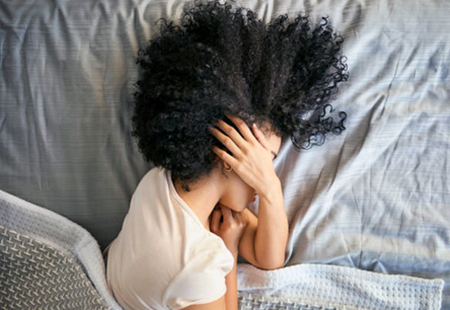
1. Acute Eustachitis: characterized by inflammation of the Eustachian tube. The patient feels a decrease in the acuity of perception, there is a hum from the affected side, a feeling of pressure. At the same time, the general well-being may not change or change slightly, if there are no concomitant diseases. After three to four days, otitis media passes into the second stage.
2. Acute catarrhal inflammation: exudate accumulates in the ear, the patient experiences pressure, moderate pain appears, possibly a low-grade fever. When examining the organ, redness and swelling of the tissues are visible.
3. Purulent preperformative stage: there is more fluid, accumulations of pus appear in it. The inflammation worsens, the pain in the affected ear intensifies, weakness, confusion appears. At this stage, it is dangerous for pus to penetrate into adjacent tissues: for example, into the internal cavities. If you do not receive suitable treatment, the risk of complications is high: mastoiditis, meningitis, labyrinthitis.
4. Post-performative stage. The membrane bursts and pus enters the passage, but the pain in the ear diminishes.
5. Scarring. After the expiration of purulent exudate, the membrane is gradually tightened and scarred. The general state of health improves, but the patient continues to hear noises, experience unexpressed soreness in the ear.
Otitis media in children and adults does not necessarily go through all five stages: with immediate treatment, the ENT disease passes quickly, hearing is fully restored, and there is no risk of complications. If the pathology lasts more than four weeks, otolaryngologists conclude that the acute phase has passed into a chronic form.
Otitis symptoms
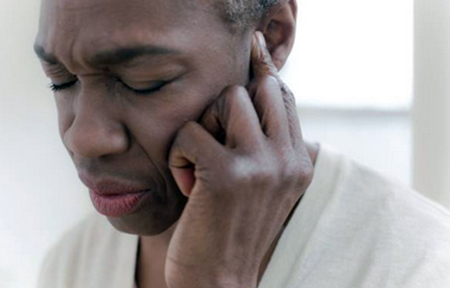
The first sign of otitis media is a decrease in hearing in one or both ears, the appearance of noise or autophony (increased perception of one's own voice). With the further development of pathology, other symptoms appear:
- Pain in the ears: from barely perceptible to unbearable, radiating to the jaw, temple, head, neck;
- Temperature rise;
- Loss of performance and general weakness;
- Hearing loss;
- The appearance of secretions in the ear canal (in the later stages of the disease).
It is necessary to seek help from an otolaryngologist when the first symptom of otitis media appears - noise and congestion in the ear. In this case, the ENT will quickly diagnose and prescribe treatment to fully restore health. The diagnosis is made based on patient’s complaints, physical/visual examination, and endoscopy, if needed for the clarification of diagnosis or establishing of the stage.
Otitis treatment
Based on the results of endoscopy and tests, the ENT doctor establishes the stage of the disease and prescribes how to treat otitis media, based on the patient's history and general condition.
Classical therapy for ENT diseases includes:
- Anti-inflammatory drops that act directly on the site of infection;
- Non-steroidal drugs that lower the temperature and help the body cope with the disease and accelerate recovery;
- Pain relievers prescribed in case of severe pain syndrome;
- Nasal drops that relieve swelling at the mouth of the Eustachian tube and improve ear ventilation;
- Antibiotics for otitis media are rarely prescribed and only in the case of an advanced form. If antibiotics are needed, it should be broad spectrum antibiotics such as Ceclor. But it is better to do susceptibility test first to be sure that the causative agent is susceptible to the particular drug.
- Physiotherapy is not prescribed due to the patient's elevated body temperature and accumulations of pus.
Otitis media is mainly treated with medication but in advanced cases, surgical intervention is possible to remove purulent exudate.
Otitis media in children
Children often develop AOM due to the following characteristics of the organism:
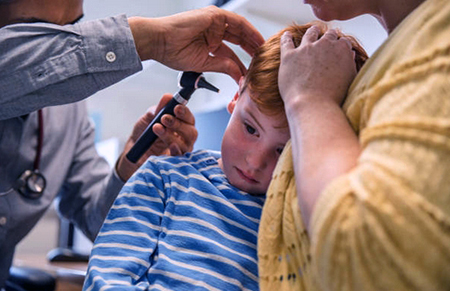
- A shortened auditory tube with an increased lumen, which increases the risk of foreign masses getting into it;
- The specificity of the mucous membrane - up to a year, it has an increased content of embryonic tissue, which serves as a breeding ground for pathogenic microorganisms;
- Reduced immune defense.
The symptoms of otitis media in children are different. The younger the child, the less pronounced the local symptoms. But the following signs of otitis media appear:
- Tearfulness;
- Sleep disturbance;
- Refusal to eat;
- The appearance of low-grade fever.
AOM develops without external reasons: otitis media in infants is caused by the ingress of amniotic fluid into the tympanic cavity or stagnation in the nasopharynx due to the constant horizontal position of the body. Therefore, it is so important to regularly visit an otolaryngologist (ENT doctor).
Treatment of otitis media in children is also made with medications but with some differences. Children under the age of two are often prescribed antibiotics by ENT doctors to quickly suppress pathogens and prevent complications. At an older age, the ENT doctor prescribes antibiotics for otitis media only if there are special indications for this (for example, the disease has developed against the background of inflammation of the adenoids).
After the child recovers, simple prophylaxis of inflammation is recommended:
- Taking complex vitamins to strengthen the immune system;
- Rinsing the nasopharynx with a special saline or other solution;
- Good ventilation of the room;
- Prevention of hypothermia (overcooling);
- Regular air and sun baths.
All this will improve the health of the baby and protect them from ear inflammation.
Treatment of otitis media in pregnant women

When an ENT doctor diagnoses otitis media in a pregnant or lactating woman, a special approach to treatment is required that is safe for both mother and child. It is important to remember that during pregnancy, it is necessary to reduce the dose of medication as much as possible and take only drugs prescribed by the doctor. At the same time, it should be remembered that it is strictly forbidden to treat otitis media independently during pregnancy. This can harm the patient's health and negatively affect the development of the fetus.
Treatment of otitis media in pregnant women is as follows:
- Anti-inflammatory drops with Lidocaine that fight the cause of infection and relieve pain;
- Antibacterial agents approved for pregnant women;
- In the case of severe AOM - safe antibiotics, taken strictly according to the scheme prescribed by the otolaryngologist.
ENT doctor should determine how to treat otitis media - only this guarantees a quick recovery and helps to maintain the health of the expectant mother and her child.
Otitis prevention
To reduce the risk of inflammation, it is recommended to follow simple prevention:
- Swim with earplugs;
- Strengthen the immune system with the help of simple exercises, walks, vitamin complexes;
- Avoid sudden hypothermia of the body (for example, do not sit under the air conditioner);
- Balance the diet: exclude fatty, spicy and smoked foods from it, diversify with vegetables and fruits;
- Do not abuse alcohol and cigarettes;
- Avoid severe stress, physical, emotional and intellectual overload.
Post by: John Avery, General Practitioner, Manchester, United Kingdom
(Updated at Apr 14 / 2024)
Ceclor articles:
Some of the trademarks used in this Web Site appear for identification purposes only.
All orders are reviewed by a licensed physician and pharmacist before being dispensed and shipped.
The statements contained herein are not intended to diagnose, treat, cure or prevent disease. The statements are for informational purposes only and is it not meant to replace the services or recommendations of a physician or qualified health care practitioner. If you have questions about the drugs you are taking, check with your doctor, nurse, or pharmacist.